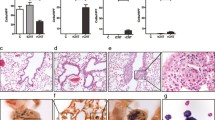Abstract
The potential health effects of inhaling carbon nanotubes are important because of possible exposures in occupational settings. Previously, we have shown mice that have inhaled multiwalled carbon nanotubes have suppressed systemic immune function. Here, we show the mechanisms for this immune suppression. Mice were exposed to 0, 0.3 or 1 mg m−3 multiwalled carbon nanotubes for 6 h per day for 14 consecutive days in whole-body inhalation chambers. Only those exposed to a dose of 1 mg m−3 presented suppressed immune function; this involved activation of cyclooxygenase enzymes in the spleen in response to a signal from the lungs. Spleen cells from exposed animals partially recovered their immune function when treated with ibuprofen, a drug that blocks the formation of cyclooxygenase enzymes. Knockout mice without cyclooxygenase enzymes were not affected when exposed to multiwalled carbon nanotubes, further confirming the importance of this enzyme in suppression. Proteins from the lungs of exposed mice suppressed the immune function of spleen cells from normal mice, but not those from knockout mice. Our findings suggest that signals from the lung can activate signals in the spleen to suppress the immune function of exposed mice.





Similar content being viewed by others
References
Stern, S. T. & McNeil, S. E. Nanotechnology safety concerns revisited. Toxicol. Sci. 101, 4–21 (2008).
Lam, C. W., James, J. T., McCluskey, R. & Hunter, R. L. Pulmonary toxicity of single-wall carbon nanotubes in mice 7 and 90 days after intratracheal instillation. Toxicol. Sci. 77, 126–134 (2004).
Muller, J. et al. Respiratory toxicity of multi-wall carbon nanotubes. Toxicol. Appl. Pharmacol. 207, 221–231 (2005).
Shvedova, A. A. et al. Unusual inflammatory and fibrogenic pulmonary responses to single-walled carbon nanotubes in mice. Am. J. Physiol. Lung Cell. Mol. Physiol. 289, L698–L708 (2005).
Warheit, D. B. et al. Comparative pulmonary toxicity assessment of single-wall carbon nanotubes in rats. Toxicol. Sci. 77, 117–125 (2004).
Mitchell, L. A. et al. Pulmonary and systemic immune response to inhaled multiwalled carbon nanotubes. Toxicol. Sci. 100, 203–214 (2007).
Li, J. G. et al. Comparative study of pathological lesions induced by multiwalled carbon nanotubes in lungs of mice by intratracheal instillation and inhalation. Environ. Toxicol. 22, 415–421 (2007).
Deng, X. et al. Translocation and fate of multi-walled carbon nanotubes in vivo. Carbon 45, 1419–1424 (2007).
Bide, R. W., Armour, S. J. & Yee, E. Allometric respiration/body mass data for animals to be used for estimates of inhalation toxicity to young adult humans. J. Appl. Toxicol. 20, 273–290 (2000).
Miller, F. J. Dosimetry of particles in laboratory animals and humans in relationship to issues surrounding lung overload and human health risk assessment: a critical review. Inhal. Toxicol. 12, 19–57 (2000).
Godwin, D. A., Wiley, C. J. & Felton, L. A. Using cyclodextrin complexation to enhance secondary photoprotection of topically applied ibuprofen. Eur. J. Pharm. Biopharm. 62, 85–93 (2006).
Cheng, Y. S., Marshall, T. C., Henderson, R. F. & Newton, G. J. Use of a jet mill for dispersing dry powder for inhalation studies. Am. Ind. Hyg. Assoc. J. 46, 449–454 (1985).
Maynard, A. D., Baron, P. A., Foley, M., Shvedova, A. A., Kisin, E. R. & Castranova, V. Exposure to carbon nanotube material: aerosol release during the handling of unrefined single-walled carbon nanotube material. Toxicol. Environ. Health A 67, 87–107 (2004).
Beck-Speier, I. et al. Agglomerates of ultrafine particles of elemental carbon and TiO2 induce generation of lipid mediators in alveolar macrophages. Environ. Health Perspect. 109 (Suppl. 4), 613–618 (2001).
Burchiel, S. W. PGI2 and PGD2 effects on cyclic AMP and human T-cell mitogenesis. Prostaglandins Med. 3, 315–320 (1979).
Chemnitz, J. M. et al. Prostaglandin E2 impairs CD4+ T-cell activation by inhibition of lck: implications in Hodgkin's lymphoma. Cancer Res. 66, 1114–1122 (2006).
Choudhry, M. A. et al. Role of NFAT and AP-1 in PGE2-mediated T-cell suppression in burn injury. Shock 18, 212–216 (2002).
Freire-de-Lima, C. G. et al. Apoptotic cells, through transforming growth factor-beta, coordinately induce anti-inflammatory and suppress pro-inflammatory eicosanoid and NO synthesis in murine macrophages. J. Biol. Chem. 281, 38376–38384 (2006).
Kim, W. J., Kim, J. H. & Jang, S. K. Anti-inflammatory lipid mediator 15d-PGJ2 inhibits translation through inactivation of elF4A. EMBO J. 26, 5020–5032 (2007).
Porter, D. W. et al. PGJ2 inhibition of LPS-induced inflammatory mediator expression from rat alveolar macrophages. J. Tox. Environ. Health 70, 1967–1976 (2007).
Fionda, C., Nappi, F., Piccoli, M., Frati, L., Santoni, A. & Cippetelli, M. PGJ2 negatively regulated rankl gene expression in activated T lymphocytes: Role of NFkB and early growth response transcription factors. J. Immunol. 178, 4039–4050 (2007).
Rajakariar, R. et al. Hematopoietic prostaglandin D2 synthase controls the onset and resolution of acute inflammation through PGD2 and 15-deoxy 12, 14, PGJ2. Proc. Natl Acad. Sci. USA 104, 20979–20984 (2007).
Acknowledgements
This work was supported by NIEHS (P30 ES-012072) and EPA (RD-83252701).
Author information
Authors and Affiliations
Contributions
L.M. conceived and designed the experiments and wrote the article. L.M. and F.L. conducted the experiments. S.B. and J.M. contributed materials and analysis tools. All authors discussed the results and commented on the manuscript.
Corresponding author
Supplementary information
Rights and permissions
About this article
Cite this article
Mitchell, L., Lauer, F., Burchiel, S. et al. Mechanisms for how inhaled multiwalled carbon nanotubes suppress systemic immune function in mice. Nature Nanotech 4, 451–456 (2009). https://doi.org/10.1038/nnano.2009.151
Received:
Accepted:
Published:
Issue Date:
DOI: https://doi.org/10.1038/nnano.2009.151
- Springer Nature Limited
This article is cited by
-
Nanoparticle asymmetry shapes an immune response
Nature (2022)
-
Serum peptidome: diagnostic window into pathogenic processes following occupational exposure to carbon nanomaterials
Particle and Fibre Toxicology (2021)
-
Reactive Oxygen Species-Related Nanoparticle Toxicity in the Biomedical Field
Nanoscale Research Letters (2020)





